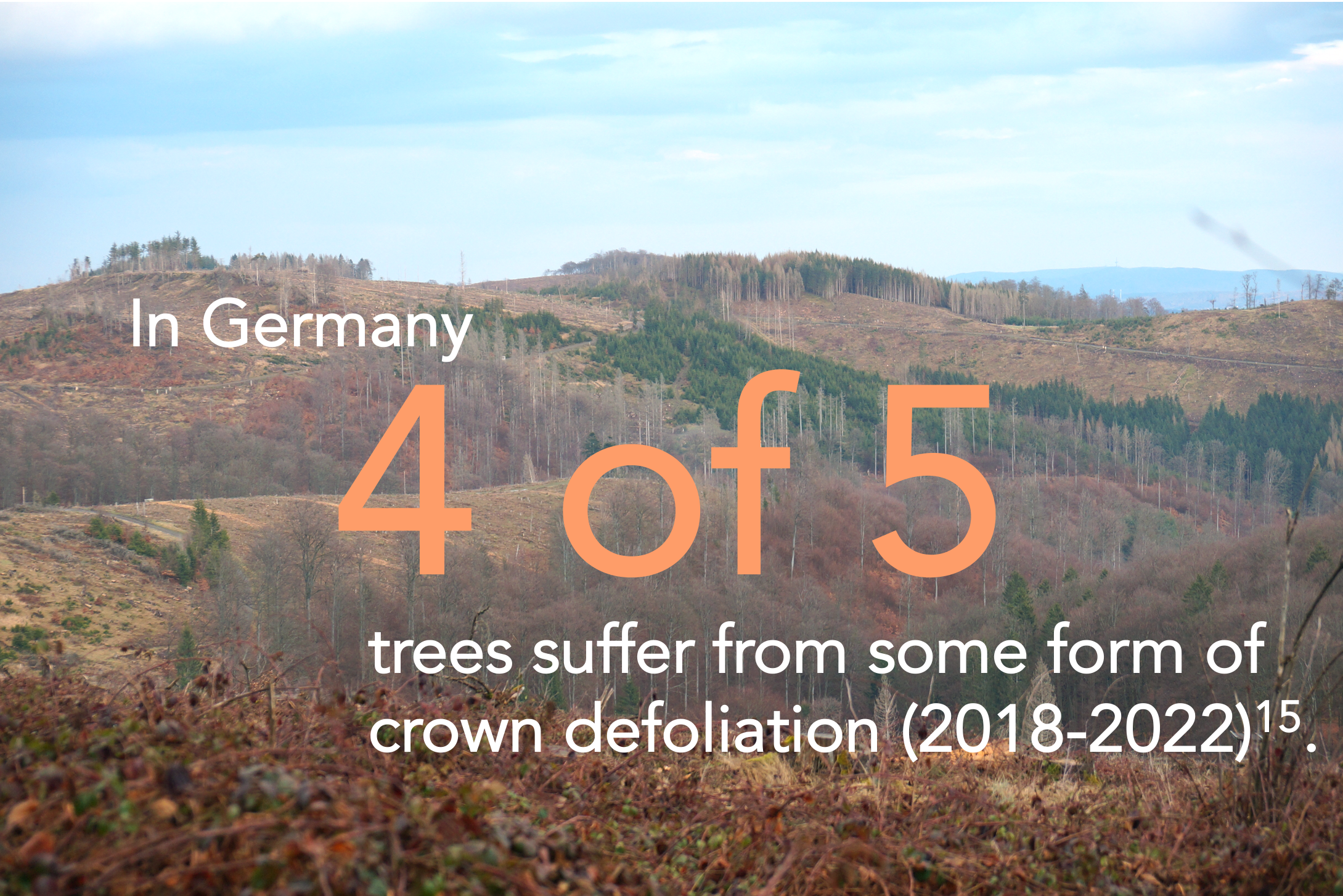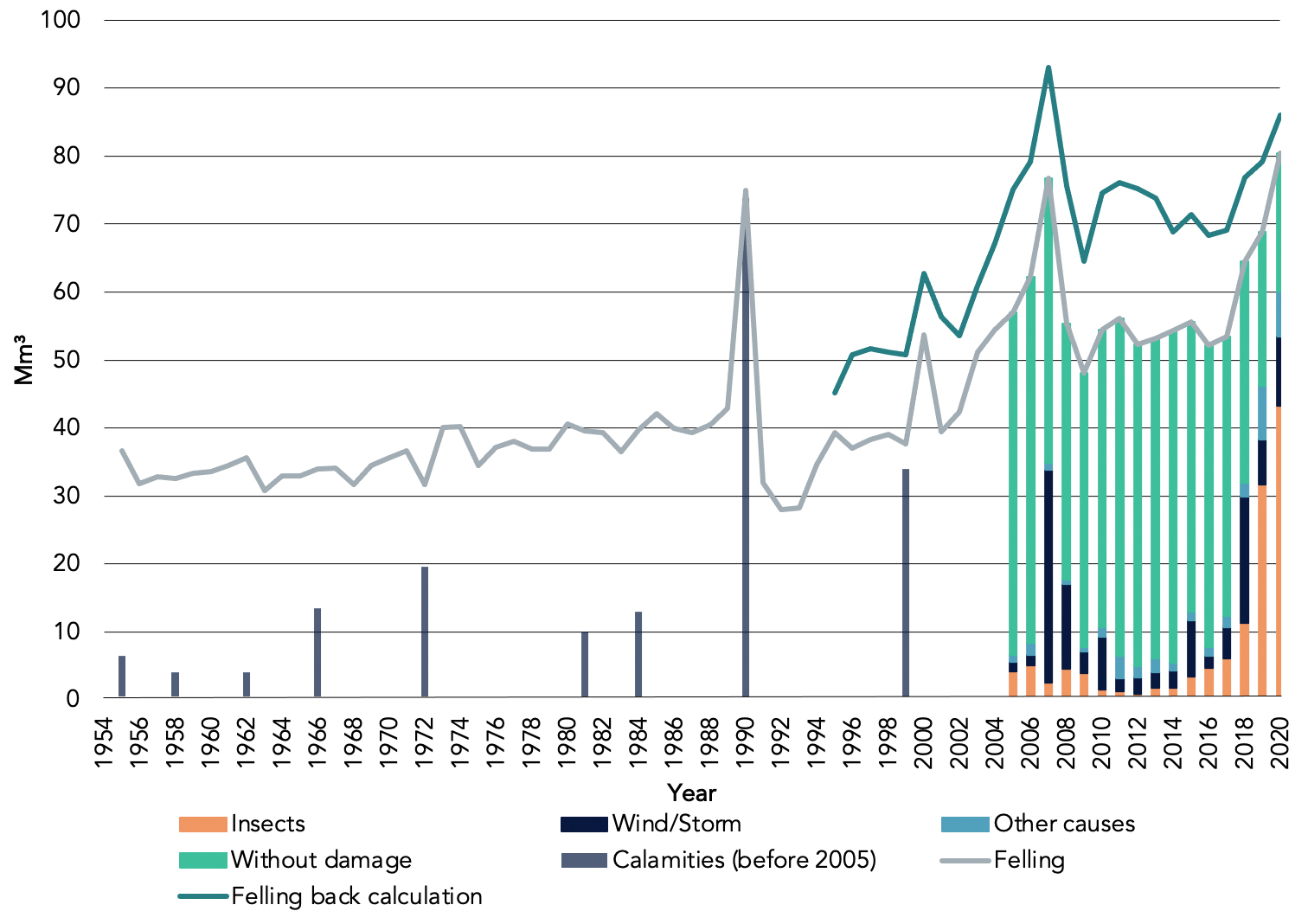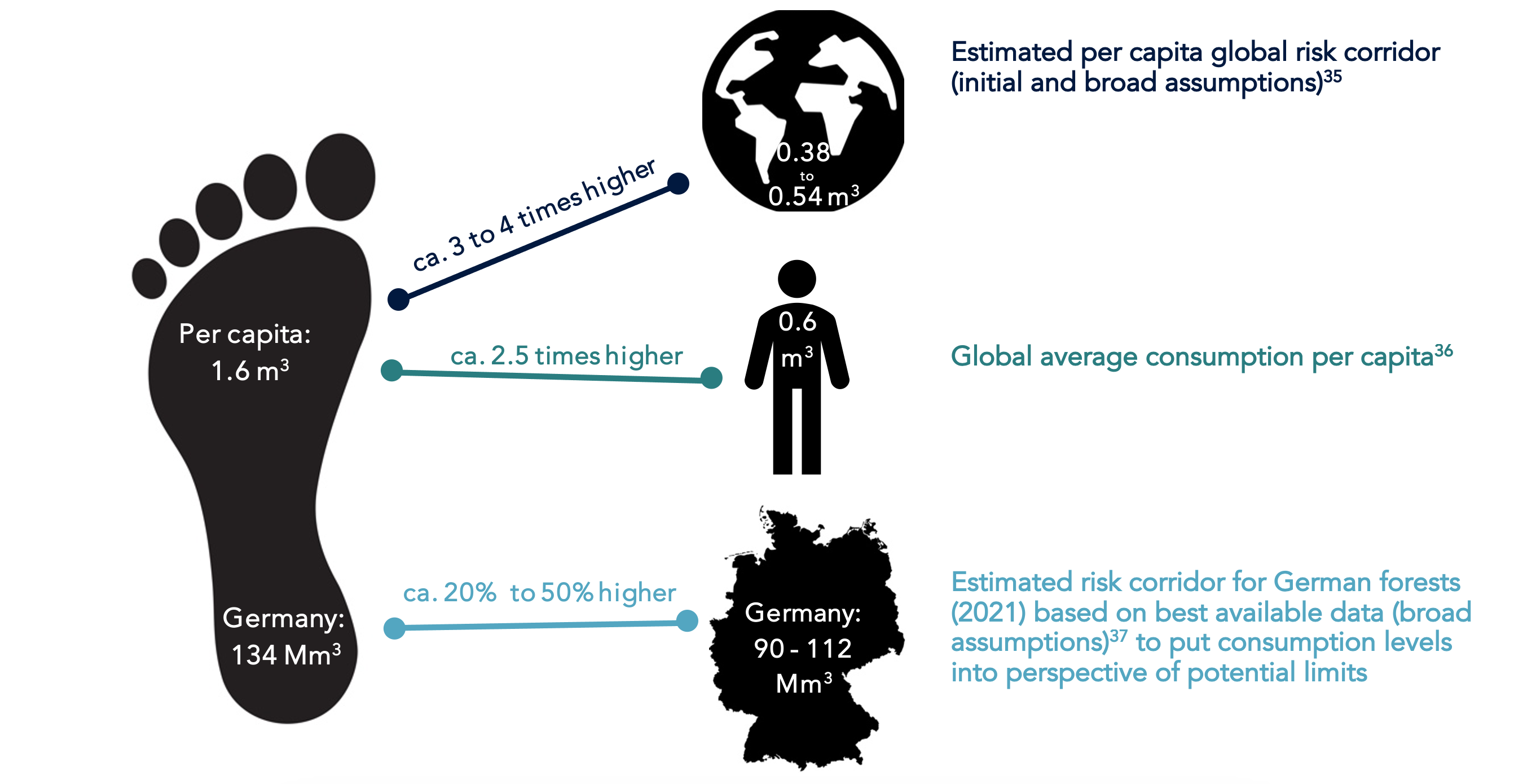Forests I Forestry I Imports and footprints
This section first looks at the state of forests in Germany to help build an understanding of the potentials and limits for expanding the forest-based bioeconomy. It presents data on the forest sector and explores where, how and how much wood is sourced within Germany and abroad to meet demands, asking critical questions about future challenges in light of trade-offs between e.g. carbon sinks and emissions.
Forests
Forests cover around 11.4 million hectares in Germany, or approximately one-third (32%) of Germany’s total territory (2011-2012) [1]. Some key characteristics include:
- Nearly half (48%) of Germany’s forests are privately owned, and around half of those forests are in holdings smaller than 20 hectares [1]. This impacts forest composition, aims and management.
- Spruce, pine, beech and oak are the most common species and combined cover nearly three-quarters (73%) of Germany’s forest territory [1]. If left to nature, deciduous trees would dominate German forests. However, conifers (predominately spruce and pine) were planted (especially after World War 2) and now make up the majority of German forests (54% by area).
- Around a quarter of Germany’s forests are characterized as monocultures (only one species) [2]. In contrast, 29% of Germany’s forest stands are classified as “close to nature” [3] and 2.8% (Stand 2019) fall under as the category “Forest with natural development“ [4]. The goal for the latter category established by the German National Biodiversity Strategy was for 5% by 2020 [5].
Unparalleled levels of disturbances impacted German forests between 2018 and 2020. These included insects (especially bark beetles), storms, heat waves and drought [6]. More than €12.7 billion in damage to forestry were estimated to be caused by extreme weather events over this time period [7]. Satellite-based data from 2021 estimate that damage may have been even higher than previously assumed—they report tree loss on around 500 thousand hectares (or nearly 5% of Germany’s total forest area) [8].
These losses mainly affected conifers such as spruce and pine. This is also reflected in the mortality rate recorded in the forest supplement survey [9]: for spruce, it increased from mean values of approx. 1% to over 10% in 2020 and 2021. For beech, the increase from a mean value of 0.3% to 0.8% in 2019 was significantly lower [9]. For that reason, one goal of forest policy is to increase the share of deciduous species in Germany [10]. These show greater resilience against e.g. insects and climate change impacts and also add to the diversity of plant and animals species [11]. However, conifers are, currently and in general, more attractive to industry. Timber of conifers has properties that are difficult to replace, especially for construction [12]. This shift could thus have far-reaching implications for the future bioeconomy. It depicts why a systems perspective that connects natural and socio-economic systems is necessary to support a balanced bioeconomy transition and get the incentives for innovation right — e.g. toward innovations that bridge supply and demand systems (examples include a focus on „long-lived“ wood products from broad leaf species such as hardwood laminated veneer timber [13] as well as insulation [14]).
Altogether, the National Forest Report 2021 concluded that the forest in Germany did not well in recent years (2018-2020). Four out of five trees in Germany suffered from crown defoliation in those years [15]. All tree species have suffered from a lack of water and almost all have shown signs of stress. The National Forest Report concluded that: “The calamities of recent years have led to the worst damage to the forest and the worst crisis in forestry since the Federal Republic of Germany began” [15]. Moving forward, the challenge is adapting German forests to meet the multiple objectives of industry, human well-being, climate and nature. Multiple projects [16] are underway to better understand the trade-offs and synergies.

© Background image: Achim Manche
Forestry
How much is harvested from German forests?
Wood harvests have increased continually over the last few decades in Germany, due to tree species composition and age structure of German forests. Periods with high natural disturbances are characterized by additional salvage logging. These removals partly compensate regular tree harvests. For example, in 2007, wood removal reached a maximum of more than 90 million cubic meters (under bark) due to the storm Kyrill [17]. Salvage logging covered about 40% of the harvested wood with large amounts of “Windwurf-Holz” in that year. In 2020 around 86 million cubic meters (under bark) were harvested and removed from German forests. Of this, 75% of wood removals came from salvage logging, due in particular to damage caused by insects and impacting primarily conifers [18]. This is a result of a three year period of strong drought, storm and insect calamities resulting in high dieback rates, especially of spruce.

German roundwood removals 1954 - 2020, showing different statistical methods and the influence of calamities on fellings. (Source: Hennenberg et al. (2022) [17]).
Notes: Felling = officially reported wood revoval (from officially reported sources and data provided by forest felling companies); Felling back calculation= additional wood harvest not covered by official statistics based on an ex-post recalculation of e.g. removals, industry surveys and stock change data. In other words, an estimation of all removals based on the known use of wood; see also Thünen Institut Felling statistics [19].
What are German removals used for?
- Half of German harvests in 2017 were used by the sawmilling industry to produce sawn wood [20]. This was comprised of conifers (93%). A very small share of deciduous species (ca. 0.2 million cubic meters) were used for veneer and plywood production.
- Just over 30% of German harvests were used directly for energy in 2017. Most energy wood was comprised of deciduous species (62%). The majority was used in households for heating. Around 7% of Germany’s 2017 harvest was burned in power plants [20].
- Just under 20% of Germany’s harvested wood was used by industry in 2017 to produce pulp and cellulose (e.g. for paper production) and fiber and chipboard. Around three-quarters of industrial uses were met with conifers [20].

Domestic use of wood in Germany, 2017 in roundwood equivalents. (Source: Based on the
flow chart by Thünen-Institut für Waldwirtschaft, Thünen-Einschlagsrückrechnung [20]).
What are some of the sustainability considerations?
A founding principle of forest management was developed in Germany over 300 years ago—that no more is removed than grows annually [21]. Over the years this production-oriented perspective has evolved to also include social, well-being, ecological and economic considerations [22] across multiple levels of management (from individual forest stands to worldwide forests). German production levels are estimated to be within the sustainable production capacities of German forests (general consensus currently [23]). However, German consumption levels already exceed these limits (see the footprints below). This raises complex questions. For example, in our efforts to halt climate change:
Is it better to harvest wood and use it in the bioeconomy (e.g. as a substitute for mineral-based products) or to leave trees in the forest (as a carbon sink and for ecological service provision)?
In Germany, forests were estimated to fix around 56 million tonnes of CO2 per year (in e.g. 2017) [24]. A further 6 Mt CO2 annually were estimated to be stored additionally in wood-based products over the same time period. Combined, this implies that forests and wood-based products store the equivalent of 7% of Germany’s annual GHG emissions. However, major forest disturbances (drought and die-back) may significantly impact both the data emerging for recent years (overestimating the sink) as well as future potentials [24]. This underscores the urgent need to better manage forests for their provision of ecosystem services.
When looking at the forest, there is no “one shoe fits all” approach to carbon accounting - carbon sequestration and storage are tied to factors like stand productivity, age and management as well as to tree species and growing conditions. One study has found that using primary woody biomass from forests for energy and in short-lived wood products “usually leads to little or no reduction in GHG emissions compared to the fossil fuel benchmark” [25]. The climate protection effect is higher if trees that are mainly used for such purposes are not harvested [26]. However, exceptions exist (e.g. salvage logging, forest restructuring, wildfire prevention), highlighting that carbon accounting requires a systems approach [27] and transparency about aims, parameters and scale [28]. The “sink potential” of wood-based products also appears stronger when wood is used for long-lived products (like in construction [29], but also depending on the overall scale of use). Such applications could lead to co-benefits for strengthening regional supply chains, promoting innovation [30] and growing local jobs (especially in rural areas and for both low and high tech employment).
The forestry and wood industry sectors employed around 1 million people in Germany (in 2019). It was estimated that the sectors combined generated 56 billion in gross value added in 2019 [31].
In the medium term, the challenge is to establish forest management that leads to climate-resilient and ecologically valuable forest stands. Depending on local conditions, this requires a wide range of management measures, from forest conversion and the promotion of valuable timber to extensification and the building up of timber stocks. In this way, goals for climate, nature and environmental protection can be achieved and, at the same time, a stable supply of wood can be ensured, primarily for durable wood products. This will also help to avoid volatile price peaks [32], which lead to hardships for industry, business and consumers, for example.
The question for monitoring is: how much primary wood from forests is available, and under what conditions? The answer is central to being able to assess trade-offs and potentials, and to provide a stable and sustainable long-term supply outlook for getting the signals for investment “right” today.
Imports and footprints
The German timber consumption footprint was 134 Mm3 over bark in 2021 [33]. According to this method, around half of the timber consumed in Germany stems from Germany (in roundwood equivalents). Around one-quarter is imported from within Europe whereas the other quarter is imported from countries across the world (especially China, Russia, the USA and Canada). Germany also exports large amounts (around one-third of removals in 2021).

Composition of the German Timber Consumption Footprint 2021 in roundwood equivalents.
(Source: Based on Egenolf et al. (2022) [33]).
Note: The footprint consists of the primary flows sourced from forests (in Germany and abroad). Exports of primary wood harvested in Germany are subtracted. More information on the calculation method in the footprints database.
What are the sustainability considerations linked to German consumption levels?
Already today, Germany’s timber consumption footprint is higher than the quantity that can be sustainably harvested from Germany’s forests on an annual basis [33]. There is a risk of increasing imports at levels that overburden the global forest area, both in terms of ecosystem integrity and fair distribution [34]. What and how much pressure is judged acceptable in the trade-off between supply and conservation should be addressed within society. Initial results on three gradients of benchmarks for evaluating the level of German consumption against sustainability limits are illustrated below. They show that according to these estimates, total German consumptions levels are already too high.

© Background image: Ovidiu; popcornarts; Icons-Studio; Holthoff, Adobe Stock
Germany’s timber footprint and illustrative comparative benchmarks. (Sources: based on Beck-O'Brien et al. (2022) [34]).
For more information see: global risk corridor [35]; global average consumption [36]; German forests [37]
High levels of demand also carry the risk of making illegal activities more attractive. Between 15 and 30% of globally traded wood is estimated to be obtained illegally [38]. Forestry crimes (including illegal logging and deforestation) have been described as “the single greatest threat to life on the planet, eradicating more species and numbers than any other human activity” [39]. There is a massive imbalance between the profits and incentives for forestry crime and measures to combat them.
Outlook
Future wood consumption must be smarter (such as better use of recycled fibres and eliminating wasteful practices, related to packaging, paper, throw-away products, etc.). Prioritising long-lived instead of disposal products and material over energy use by developing appropriate incentive structures could also enable the kinds of new, high-value innovations characteristic of a sustainable and circular bioeconomy, as envisoned by the German Bioeconomy Strategy. To that end, not only sustainable supply, but also sustainable consumption must be actively addressed, promoted and monitored.
Notes and references
- Data is from the Third German National Forestry Inventory (conducted in the years 2011/2012), as summarized in the report “The Forests in Germany” (BMEL 2014). Extensive information is available at https://www.bundeswaldinventur.de/en/ and data for users to develop their own charts is available at https://bwi.info/start.aspx. FNR also provides an overview of the forest and forest industry in Germany with e.g. factsheets: https://www.fnr.de/fileadmin/Projekte/2019/Mediathek/Basisdaten_KIWUH_web_2te_Auflage_Okt.pdf. The Fourth National Forest Inventory is underway (2022).
- Holzwarth et al. (2020). Earth Observation Based Monitoring of Forests in Germany: A Review. Remote Sens. doi: 10.3390/rs12213570.
- Three categories were distinguished in the study by Böttcher et al. (2022): “Naturnah” (29%), “Bedingt naturnah” (23%) and “Naturfern” (48%). The classification was performed by Öko-Institute on the basis of data from Thünen Institute (2014) (Dritte Bundeswaldinventur, 2012) with the aim of distinguishing potential forest systems for ecosystem services payments. See Table 1 in Böttcher et al. (2022). Entwicklung eines finanziellen Anreizsystems für zusätzliche Klimaschutz- und Biodiversitätsleistungen im Wald. Climat. chang. Available at: https://www.umweltbundesamt.de/en/publikationen/entwicklung-eines-finanziellen-anreizsystems-fuer .
- BfN (2020). The State of Nature in Germany. Available at: https://www.bfn.de/sites/default/files/BfN/natura2000/Dokumente/bericht_lage_natur_2020.pdf
- Natural and close-to-natural forests are crucial to providing ecosystem services, securing habitats for biodiversity, and increasing forest resilience. See also BMUV (2019). Indicator Report 2019 of the Federal Government under the National Strategy on Biological Diversity. Available at: https://www.bmuv.de/fileadmin/Daten_BMU/Download_PDF/Naturschutz/indikatorenbericht_2019_en_bf.pdf.
- See e.g. the data and article from Destatis (2021). Waldschäden: Schadholzeinschlag durch Insektenbefall binnen fünf Jahren mehr als verzehnfacht. Available at: https://www.destatis.de/DE/Presse/Pressemitteilungen/2021/08/PD21_N050_41.html (accessed Dec. 2022)
- Möhring et al. (2021). Schadenssumme insgesamt 12,7 Mrd. Euro. (Abschätzung der ökonomischen Schäden der Extremwetterereignisse der Jahre 2018-2020 in der Forstwirtschaft. Available at: https://www.waldwissen.net/assets/FVA/Waldwirtschaft/12_7_Mio_Schaden/2021_02_DFWR_Waldscha__den.pdf (accessed Dec. 2022)
- Data was collected by the Deutsches Zentrum für Luft und Raumfahrt (2022).Concern about German forests. Available at: https://www.dlr.de/content/en/articles/news/2022/01/20220221_concern-about-german-forests.html (accessed Dec. 2022)
- Explore the data online: https://tiwo-wze.shinyapps.io/WZE_app_mit_Ausscheiderate/; Sum of “Vollständiger Nadel-/Blattverlust” (drought), „Abiotisch bedingter Ausfall“ (e.g. windthrow) and “Biotisch bedingter Ausfall” (e.g. bark beetle)
- Deciduous species increased by +7% between 2002 and 2012 (BMEL 2014) (see footnote [1] above)
- Deciduous species „fördern auf vielen Standorten bodenbildende Prozesse, die Grundwasserneubildung, die Vielfalt der Tier- und Pflanzenarten sowie die Stabilität und Anpassungsfähigkeit der Waldbestände zum Beispiel gegen Schaderreger, Sturm und Klimaänderung“ [promote soil-forming processes, groundwater recharge, the diversity of animal and plant species, and the stability and adaptability of forest stands, for example, against pests, storms, and climate change at many sites] BMUV (2019). Indicator Report 2019 of the Federal Government under the National Strategy on Biological Diversity. Available at: https://www.bmuv.de/fileadmin/Daten_BMU/Pools/Broschueren/indikatorenbericht_2019_bf.pdf (accessed Dec. 2022)
- The industrial use of deciduous species is increasing, but critical challenges remain: BMEL and BMUV (2020). Laubholz kann Nadelholz beim Bauen noch nicht ersetzen. Available at: https://www.waldklimafonds.de/service/presse/presse-detail/laubholz-kann-nadelholz-bei-bauen-noch-nicht-ersetzen
- An example is e.g. BauBuche. Available at: https://www.pollmeier.com/products/baubuche-about
- For example with innovative technologies to make it possible to use Beechwood fibre for insulation. See the press release about a recent project available at: https://news.fnr.de/fnr-pressemitteilung/neue-mahlscheiben-zur-herstellung-von-holzfasern-fuer-daemmstoffe
- BMEL (2023). Waldzustandserhebung 2022. Available at: https://www.bmel.de/SharedDocs/Pressemitteilungen/DE/2023/030-waldzustandserhebung.htmlI and BMEL (2021). Waldbericht der Bundesregierung 2021. Available at: https://www.bmel.de/SharedDocs/Downloads/DE/Broschueren/waldbericht2021.pdf?__blob=publicationFile&v=11. See also information on the tree crown survey at: https://www.thuenen.de/en/wo/fields-of-activity/soil-protection-and-forest-health/crown-condition-survey/
- See for example the following sources, projects and links:
- UBA-Projekt THG-Projektionen: „Politikszenarien für den Klimaschutz X“
- DEFENs: Dealing with Impacts on Forests under changing End-use demand, climate change, Natural disturbances and Policy goals (Waldklimafond)
- BioSINK: Impact of the use of forest biomass for energy in Germany on German and international LULUCF sinks (UBA)
- LANDMARC: LAND use based MitigAtion for Resilient Climate pathways (EU, Horizon 2020). Available at: https://www.landmarc2020.eu/germany-forest-management
- UBA-CARE: Transformation zu einem vollständig treibhausgasneutralen Deutschland (engl. UBA-CARE: Transformation to a completely greenhouse gas neutral Germany). Available at: https://ubacare.com/.
- waldvision.de
- https://co2-speichersaldo.de/en/index.html
- Hennenberg et al. (2022). Aktuelle Nutzung und Förderung der Holzenergie. Climat. chang. Available at: https://www.umweltbundesamt.de/publikationen/aktuelle-nutzung-foerderung-der-holzenergie .
- More Information on how Destatis calculates fellings and breakdown by tree species, state and calamity shares. Available at: https://www.destatis.de/DE/Themen/Branchen-Unternehmen/Landwirtschaft-Forstwirtschaft-Fischerei/Wald-Holz/Publikationen/Downloads-Wald-und-Holz/holzeinschlag-2030331207004.pdf?__blob=publicationFile
- Einschlagsrückrechnung by Thünen Institute. Available at: https://www.thuenen.de/en/institutes/forestry/figures-facts/fellings-and-roundwood-use. More information on how Thünen Institute calculates fellings and breakdown by tree species, use and calamity shares: Jochem et al. (2021). National wood fiber balances for the pulp and paper sector: An approach to supplement international forest products statistics. doi: 10.1016/j.forpol.2021.102540.
- Thünen Institute calculation of resource flows (2017). Available at: https://www.thuenen.de/media/institute/wf/HM_div._Statistik_Dateien/Dateien_-_Bilanzen_-_Tabellen/Wald/Einschlagrueckrechnung/Rohholz_Inlandsverwendung.pdf
- „Carlowitz 1713 in seinem Werk "Sylvicultura oeconomica" erstmals, dass immer nur so viel Holz geschlagen werden sollte, wie durch planmäßige Aufforstung wieder nachwachsen kann“ Available at: https://www.bmel.de/DE/themen/wald/wald-in-deutschland/carlowitz-jahr.html
- For more information on forest models for Germany to assess aspects of sustainability see:
- Forest model WEHAM: Thünen-Institut (2012). Waldentwicklungs- und Holzaufkommensmodellierung. Available at: https://bwi.info/start.aspx; Oehmichenet al. (2018). Die alternativen WEHAM-Szenarien: Holzpräferenz, Naturschutzpräferenz und Trendfortschreibung - Szenarienentwicklung, Ergebnisse und Analyse. doi: 10.3220/REP1527686002000. Available at: https://literatur.thuenen.de/digbib_extern/dn059875.pdf
- Forest model 4C: Gutsch et al. (2018). Balancing trade-offs between ecosystem services in Germany’s forests under climate change. Res. doi: 10.1088/1748-9326/aab4e5
- Forest model FABio: Böttcher et al. (2018): Waldvision Deutschland. Available at: https://waldvision.de/index-4.html
- See Egenolf et al. (2022) for a compilation of different sources and trends for sustainable supply capacities (see also footnote [37] below) compared to production levels and consumption levels. For production levels, the analysis shows that production is currently below estimates of sustainable supply capacity, but that this could change in the near future. Egenolf et al. (2022). The timber footprint of German bioeconomy scenarios compared to the planetary boundaries for sustainable roundwood supply. Sustain. Prod. Consum.
- Data refer to an average for 2016-2020, but significant forest disturbances (drought and die-back) are not yet included in the accounting and the forest sink for the years 2018-2020 may be significantly overestimated. See:
- FNR (2022). Klimaschutzeffekt von Wald und Holz, based on
- UBA (2022). Nationale Trendtabellen für die deutsche Berichtserstattung atmosphärischer Emissionen 1990–2020, EU Submission, and
- Destatis (2022). Kohlenstoffbilanz des Waldökosystems. Available at: https://www.destatis.de/DE/Themen/Gesellschaft-Umwelt/Umwelt/UGR/landwirtschaft-wald/Tabellen/kohlenstoff-waldoekosystem.html
- Luick et al. (2021). Primeval, natural and commercial forests in the context of biodiversity and climate protection – Part 2: The Narrative of the Climate Neutrality of Wood as a Resource. Naturschutz und Landschaftsplanung.
- Fehrenbach H. et al. (2022). The Missing Limb: Including Impacts of Biomass Extraction on Forest Carbon Stocks in Greenhouse Gas Balances of Wood Use. Forests. doi.org/10.3390/f13030365
- Cowie et al. (2021). Applying a science-based systems perspective to dispel misconceptions about climate effects of forest bioenergy. GCB Bioenergy. doi.org/10.1111/gcbb.12844
- See the CO2 storage balance online: https://co2-speichersaldo.de/en/index.html and the online blog addressing these questions: https://blog.oeko.de/red-iii-methodik-in-der-treibhausgasbilanz-fuer-energieholz-fehlt-ein-wichtiger-aspekt-der-ipcc-regeln/. Further academic sources include: Waring et al. (2020). Forests and Decarbonisation – Roles of Natural and Planted Forests. doi: 10.3389/ffgc.2020.00058.; Noormets et al. (2015). Effects of forest management on productivity and carbon sequestration: A review and hypothesis. doi: 10.1016/j.foreco.2015.05.019; as well as Luyssaert et al. (2008). Old-growth forests as global carbon sinks. doi: 10.1038/nature07276. and its counteragument: Gundersen et al. (2021). Old-growth forest carbon sinks overestimated, doi: 10.1038/s41586-021-03266-z.
- Hafner et al. (2017). Treibhausgasbilanzierung von Holzgebäuden – Umsetzung neuer Anforderungen an Ökobilanzen und Ermittlung empirischer Substitutionsfaktoren (THG-Holzbau). Available at: https://www.ruhr-uni-bochum.de/reb/mam/content/thg_bericht-final.pdf
- See e.g. Acatech (2022). Wood-based Bioeconomy: Sustainable, Circular, Climate-resilient. National Academy of Science and Engineering. Position paper. Available at: https://www.acatech.de/publikation/holzbasierte-biooekonomie/
- Based on the cluster statistics of Thünen Institute of Forestry for both Forestry and wood industry sectors combined (for the year 2019).
- See for example the 10-year price trend for tracking commodity prices (international, USA). Available at: https://tradingeconomics.com/commodity/lumber.
- Egenolf et al. (2022). The timber footprint of German bioeconomy scenarios compared to the planetary boundaries for sustainable roundwood supply. Sustain. Prod. Consum.
- Beck-O’Brien et al. (2022). Everything from wood – The resource of the future or the next crisis? How footprints, benchmarks and targets can support a balanced bioeconomy transition. WWF Germany.
- An initial risk corridor (3 to 4.2 billion m3) was calculated based on the estimated forest available for wood supply (currently 47%), a global average productivity of 2.5 m3 per ha and year for production forests and 9.3 m3 per ha and year for plantations and a harvest rate of 50% (low risk) to 80% (high risk). The aim of the proposed benchmark was to initiate a discussion on sustainable supply capacities by taking a first step toward developing an approach to translate planetary boundaries to wood consumption. Population data was from the UN. See footnote [34] above.
- Global consumption statistics are based on FAO data and UN population statistics. Data is converted to be depicted over bark and include harvest losses and a trees-outside-the forest adjustment to make the data comparable. See footnote [34] above.
- 112 Mm3 based on the WEHAM nature preference scenario, adjusted by footnote [33] for bark and harvest losses, and noting that the WEHAM model scenario makes assumptions about e.g. tree age and stand composition, making comparability limited (here only for the purpose of indicating an order of magnitude that puts consumption into the perspective of potential limits). 90 Mm3 corresponds to harvesting 80% of the net growth estimated by the 3rd National Forestry Inventory on productive forests — see footnote [33] — and note that the low-risk boundary (50% harvest rate of NAI in source 34) would be closer to 60 Mm3 . WEHAM: Oehmichen et al. (2018). Die alternativen WEHAM-Szenarien: Holzpräferenz, Naturschutzpräferenz und Trendfort-schreibung. Szenarienentwicklung, Ergebnisse und Analyse. Thünen Institute.
- Nellemann (2012). Green Carbon, Black Trade: Illegal Logging, Tax Fraud and Laundering in the World’s Tropical Forests. INTERPOL and UNEP.
- Nellemann et al. (2020). Forestry Crimes and Our Planet. In The Wicked Problem of Forest Policy, Cambridge University Press, pp 197–230.



